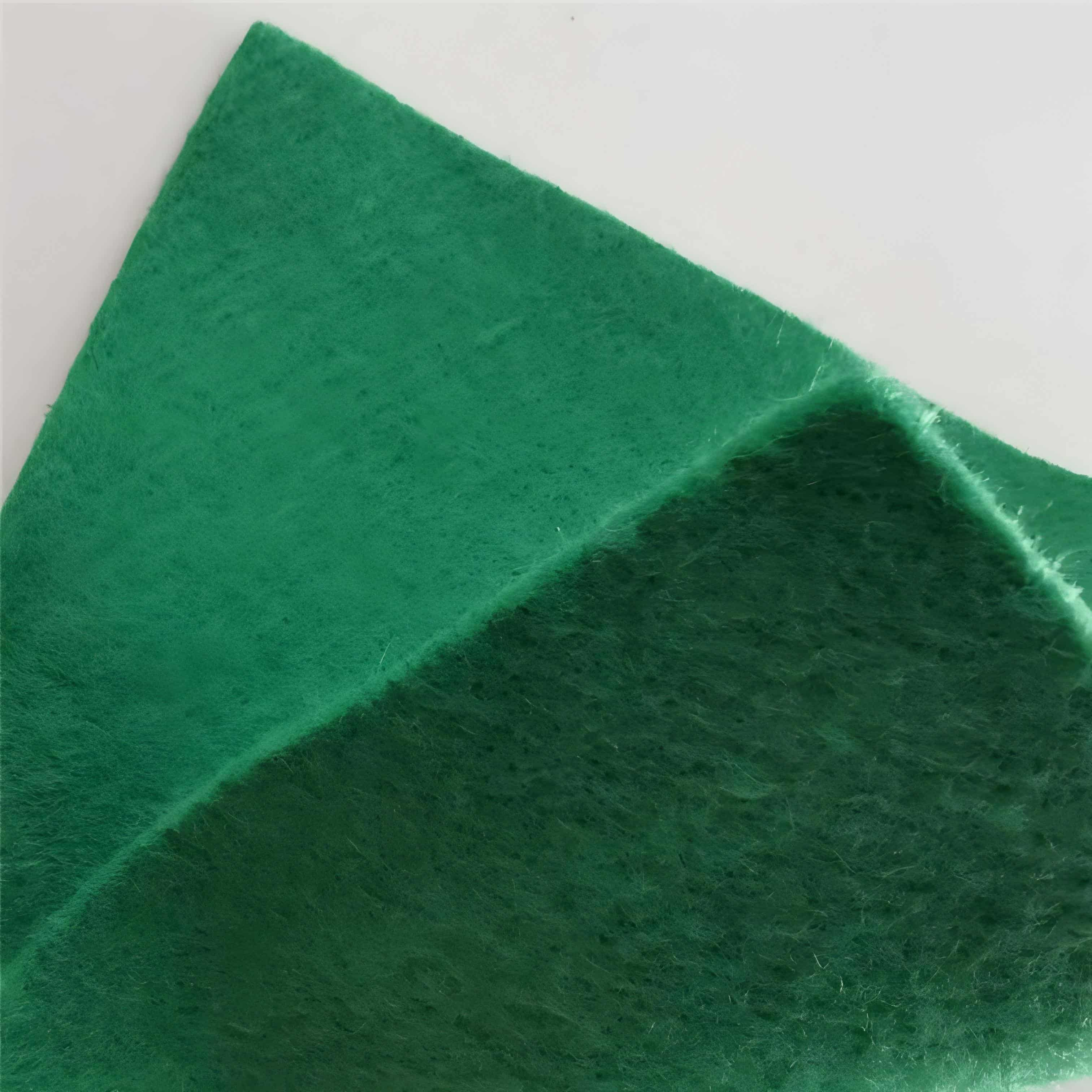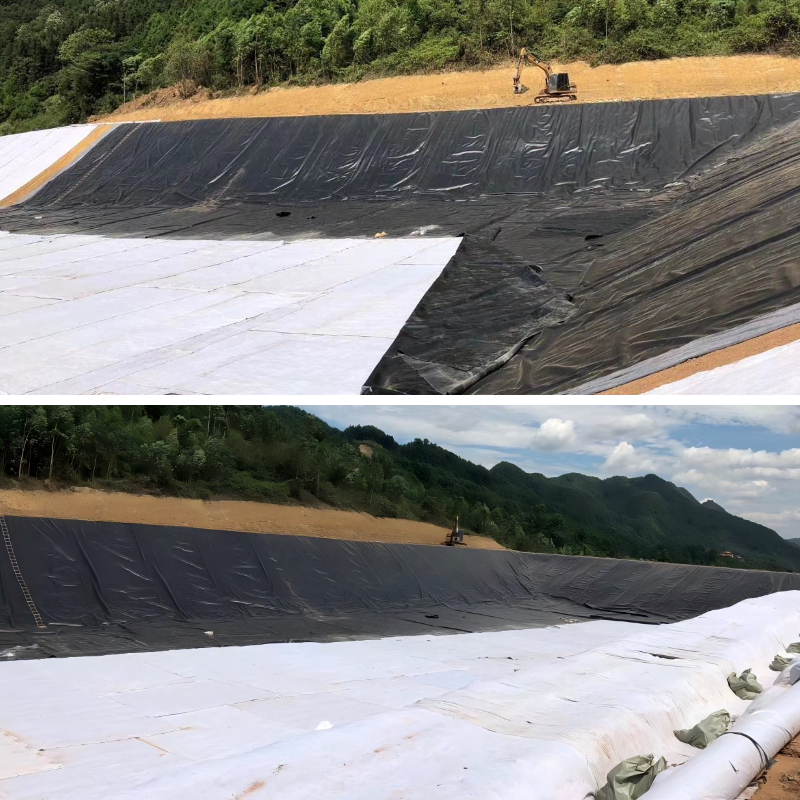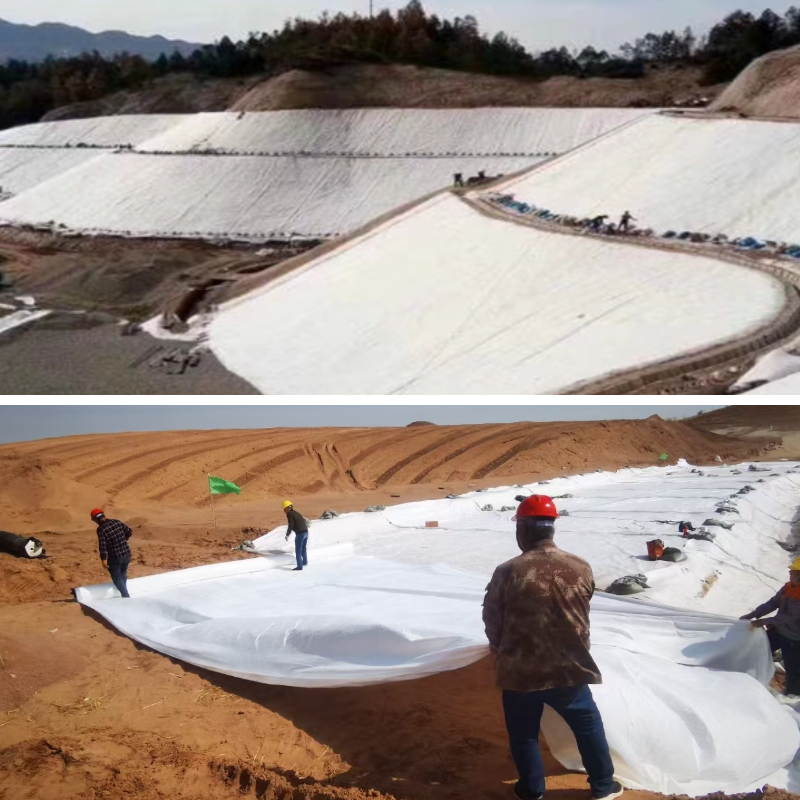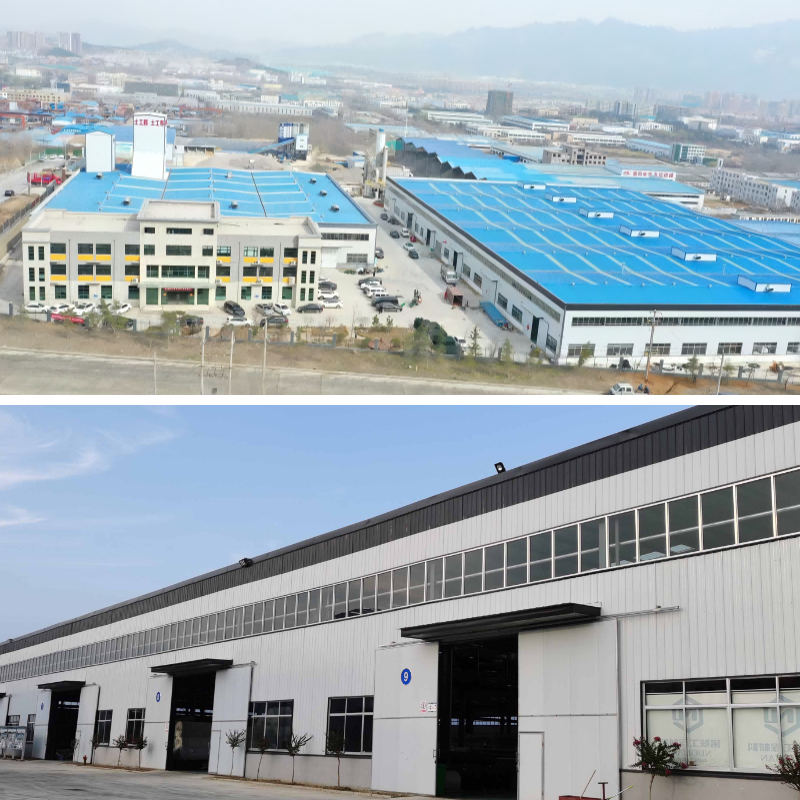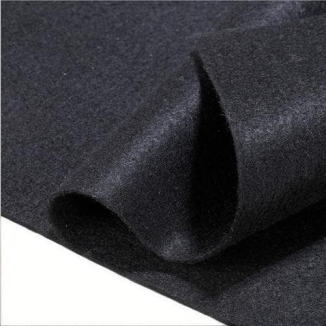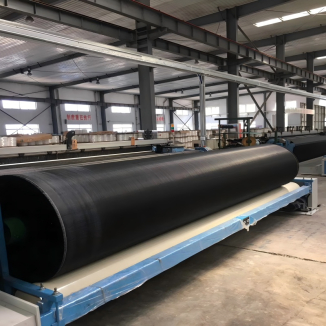Non Woven Polyester Geotextile
1.Good water filtration: The porous structure can retain soil particles, facilitate quick drainage, and prevent water accumulation and erosion;
2.High strength: Tensile and tear resistance, reinforcing roadbed and embankment, reducing deformation;
3.Long term weather resistance: UV resistant, acid and alkali resistant, stable performance for long-term use;
4.Easy to use and save money: Easy to lay, fast construction, low cost, high cost-effectiveness.
Product Introduction
I. Basic Properties: Raw Materials and Processing Lay the Foundation for Characteristics
Non Woven Polyester Geotextile are made from polyethylene terephthalate (PET), primarily sourced from recycled polyester bottle flakes or industrial-grade polyester chips, offering both environmental friendliness and raw material stability. They are produced using a typical non-woven process, primarily a "spunbond + needlepunch" or "spunbond + hot-calendering" combination. The spunbond process creates a continuous fiber web through high-temperature melt spinning, ensuring fundamental strength. The needlepunch or hot-calendering process further interweaves and consolidates the fibers, creating a uniform three-dimensional porous network structure. The resulting product is soft yet resilient, typically with a thickness between 0.5 and 3 mm, and a weight per unit area (grammage) ranging from 100 to 800 g/m2, which can be flexibly adjusted to meet project requirements.
II. Core Function: Targeted Solutions to Key Project Issues
Dual Filtration and Drainage: Its porous structure features uniform pore sizes (typically 0.05-0.2mm), effectively blocking fine soil particles and preventing soil erosion (e.g., preventing sediment from seeping into the drainage layer during roadbed construction). It also creates a smooth water flow path, rapidly draining accumulated water within the project area (e.g., draining the backslope of dams and underground garage roofs). This effectively reduces soil moisture content and prevents cracking and subsidence caused by water erosion.
Reinforcement and protection: Polyester offers high tensile strength (vertical and transverse tensile strengths of 10-50 kN/m). Combined with the interwoven structure of non-woven fibers, it provides additional support for engineering structures such as roadbeds, embankments, and slopes, distributing external loads (such as road vehicle impact and embankment earthwork pressure) and reducing structural deformation. Furthermore, it acts as a protective layer to separate different materials (e.g., separating the soil and gravel layers in a roadbed), preventing material mixing that could impact project quality. It also protects fragile materials like geomembranes from puncture by sharp stones.
III. Key Features: Practical Advantages Suitable for Project Scenarios
High Durability and Adaptability to Complex Environments: PET material inherently exhibits excellent aging resistance and is resistant to long-term UV exposure (performance degradation of no more than 20% after 5-8 years of outdoor use). It is also resistant to acid and alkali corrosion (stable in soil and water with a pH of 3-11) and resists microbial degradation (not susceptible to soil bacteria and fungi). It maintains stable performance over time even in harsh environments such as humid, saline-alkali soils, and outdoor environments, extending the overall service life of the project.
Easy Construction and Controllable Overall Costs: The finished product is mostly in roll form (2-6m wide and 50-100m long). It is lightweight (weighing only 100-800g per square meter), requiring no large equipment for transportation and installation. Its excellent flexibility allows it to conform tightly to irregular terrain such as slopes and depressions, reducing construction complexity. The raw materials are readily available and recyclable. Compared to traditional reinforcement materials (such as geogrids and woven geotextiles), it offers lower production and construction costs and an excellent overall cost-effectiveness.
Environmentally friendly and compliant with green engineering requirements: 30%-50% recycled polyester can be incorporated into the raw materials to reduce plastic waste pollution. At the end of its lifespan, the product can be professionally processed and recycled, and it releases no harmful substances into the natural environment, meeting the current development needs of "green infrastructure."
Product Parameters
project | metric | ||||||||||
Nominal strength/(kN/m) | |||||||||||
6 | 9 | 12 | 18 | 24 | 30 | 36 | 48 | 54 | |||
1 | Longitudinal and transverse tensile strength / (kN/m) ≥ | 6 | 9 | 12 | 18 | 24 | 30 | 36 | 48 | 54 | |
2 | Maximum elongation at maximum load in longitudinal and transverse directions/% | 30~80 | |||||||||
3 | CBR top penetration strength /kN ≥ | 0.9 | 1.6 | 1.9 | 2.9 | 3.9 | 5.3 | 6.4 | 7.9 | 8.5 | |
4 | Longitudinal and transverse tearing strength /kN | 0.15 | 0.22 | 0.29 | 0.43 | 0.57 | 0.71 | 0.83 | 1.1 | 1.25 | |
5 | Equivalent aperture O.90(O95)/mm | 0.05~0.30 | |||||||||
6 | Vertical permeability coefficient/(cm/s) | K× (10-¹~10-), where K=1.0~9.9 | |||||||||
7 | Width deviation rate /% ≥ | -0.5 | |||||||||
8 | Unit area mass deviation rate /% ≥ | -5 | |||||||||
9 | Thickness deviation rate /% ≥ | -10 | |||||||||
10 | Thickness coefficient of variation (CV)/% ≤ | 10 | |||||||||
11 | Dynamic perforation | Puncture hole diameter/mm ≤ | 37 | 33 | 27 | 20 | 17 | 14 | 11 | 9 | 7 |
12 | Longitudinal and transverse fracture strength (grab method)/kN ≥ | 0.3 | 0.5 | 0.7 | 1.1 | 1.4 | 1.9 | 2.4 | 3 | 3.5 | |
13 | Ultraviolet resistance (Xenon arc lamp method) | Longitudinal and transverse strength retention rate% ≥ | 70 | ||||||||
14 | Ultraviolet resistance (fluorescence UV lamp method) | Longitudinal and transverse strength retention rate% ≥ | 80 | ||||||||
Product Application
1. Road and Rail Transit Engineering: Ensuring Roadbed Stability and Extending Pavement Life
Roadbed Reinforcement and Isolation: Laid between the subgrade and the gravel cushion, this reinforcement distributes vehicle loads, reducing subgrade settlement and cracking (especially on soft soils). It also isolates different soil layers, preventing soil particles from mixing with gravel and preventing loosening of the subgrade structure.
Pavement Drainage Assist: Laid within the drainage layer beneath asphalt or concrete pavement, it filters rainwater that seeps into the road surface, preventing sediment from clogging drainage channels. It also quickly drains accumulated water, preventing subgrade collapse caused by rainwater soaking the roadbed.
Track Bed Protection: Used on the underside of high-speed rail and subway trackbeds, it isolates the gravel from the underlying soil, preventing gravel from sinking and soil from rising. It also drains accumulated water from the roadbed, protecting the stability of the track structure.
2. Water Conservancy and Water Transport Engineering: Seepage Prevention, Erosion Resistance, and Protection of Hydraulic Structures
Dam and Riverbank Protection: Paved on the waterfront slope of a dam or riverbank, it firstly prevents dam fill particles from being lost with the water flow through filtering action, thus preventing leakage. Secondly, it reduces direct erosion of the slope by water flow and, in combination with protective masonry materials (such as gabion mesh), enhances erosion resistance.
Canal and Reservoir Anti-Seepage Assistance: Paved as a protective layer on the upper and lower sides of the geomembrane, it prevents sharp rocks from puncturing the membrane during channel excavation. It also isolates the membrane from the soil below, preventing soil impurities from affecting the anti-seepage effect and assisting in draining water beneath the membrane.
Port and Waterway Engineering: Paved on the backfill of dock slopes or in dredged waterways, it reinforces the soil, preventing backfill from being lost due to water impact, while also filtering sediment from the water and maintaining the navigable depth of the waterway.
3. Environmental Protection and Municipal Engineering: Supporting Green Construction and Addressing Public Needs
Landfills: Serving as a supplementary layer in landfill anti-seepage systems, laid between the geomembrane and the landfill layer, it filters impurities from leachate and prevents leachate from clogging the drainage channels of the anti-seepage membrane. It also protects the membrane from puncture by sharp objects in the waste, preventing harmful substances from leaking and contaminating groundwater.
Sewage Treatment Plants: Lay it on the bottom or slope of sewage treatment tanks to separate the tank concrete structure from the surrounding soil, preventing impurities from seeping into the tank and affecting water quality. It also assists in draining accumulated water around the tank and maintaining structural stability.
Municipal Greening and Sponge Cities: Lay it beneath permeable pavement in urban green spaces, park lawns, or sponge cities to filter sediment from stormwater runoff and prevent it from clogging the permeable layer. It also directs rainwater to infiltrate or drain into the municipal pipe network, reducing urban waterlogging. It also stabilizes the soil and prevents soil erosion in green spaces.
4. Mining and Agricultural Engineering: Adapting to Special Scenarios and Improving Production Efficiency
Mining Tailings Ponds: Paved along the dam or reservoir floor of a tailings pond, reinforcing and strengthening the dam structure to prevent landslides caused by excessive tailings pressure. It also filters tailings particles from the tailings water, reducing contamination of surrounding soil and water bodies.
Agricultural Irrigation and Soil and Water Conservation: Paved along irrigation channels or terrace slopes to reduce erosion and soil erosion. It also filters sediment from irrigation water to prevent clogging of irrigation pipes, improving irrigation efficiency. In arid areas, it can also assist in water conservation and reduce soil evaporation.
With its core functions of filtration and drainage, reinforcement, and isolation and protection, non-woven polyester geotextiles have become a fundamental engineering material across diverse sectors, including roads, water conservancy, environmental protection, and agriculture. Not only do they address key challenges in different scenarios, such as structural stability, soil and water conservation, and pollution control, but they also indirectly reduce maintenance costs by improving project durability and simplifying construction. Furthermore, their environmentally friendly properties and strong adaptability make them an irreplaceable choice in green infrastructure and ecological protection projects, making them a crucial choice for modern engineering construction that balances practicality and sustainability.




